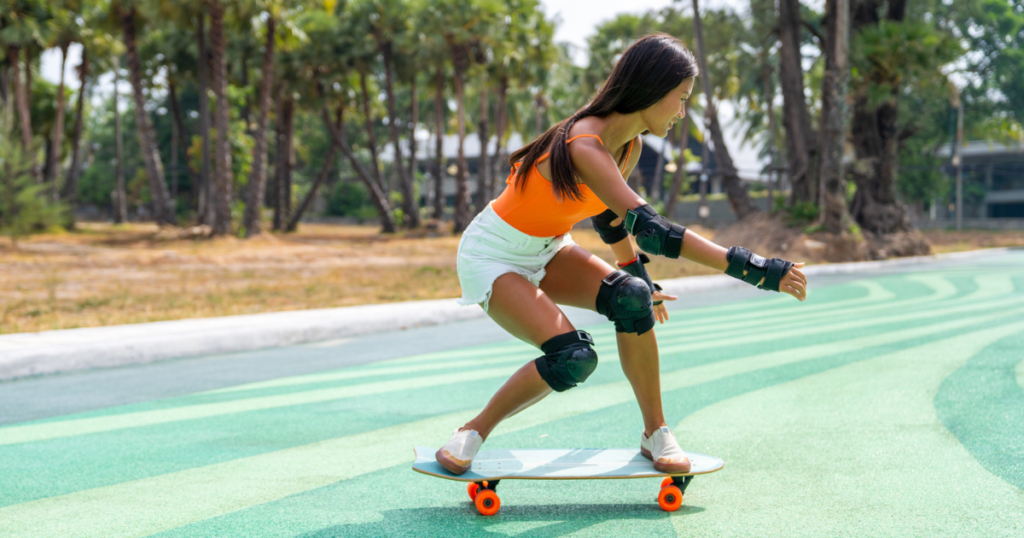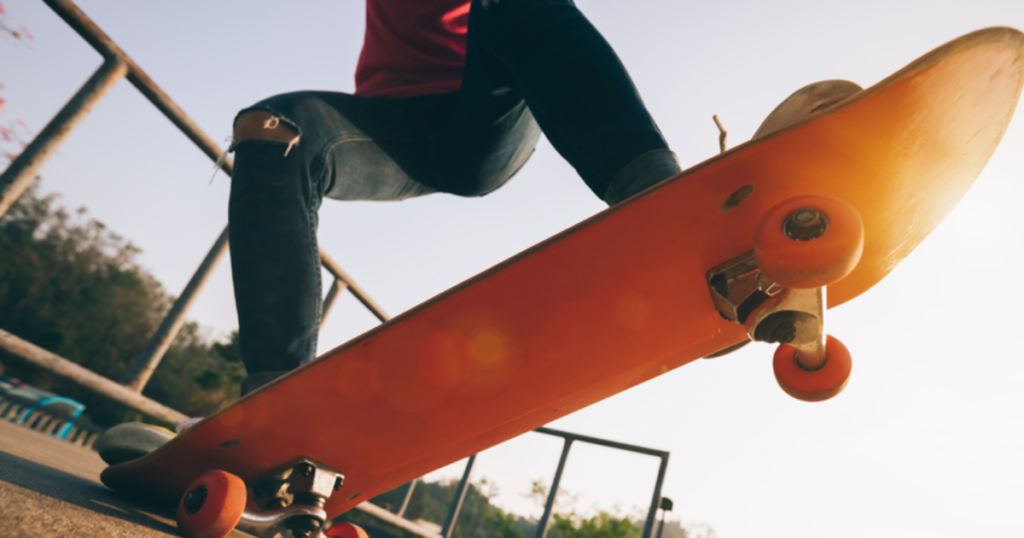Want to start skateboarding but have no idea How Long Does It Take To Learn Skateboarding? Worry not! This blog has you covered.
Skateboarding is a sport that can be learned relatively quickly. Many people who try it find that they can learn the basics within a few weeks. However, skateboarding takes time and practice to become really good at it. It can take months or even years for some people to develop the skills and techniques necessary to be skilled skateboarders.
Typically, it takes around six weeks for beginners to learn the basics of skateboarding and start having fun. Skateboarding requires some time to master, depending on your level of athletic ability, the amount of time you have available, and the extent of your dedication. If you’re not at your best, it could take weeks to master the sport confidently.
Also Read: Can You Lose Weight Longboarding – Ready For Surprise
Is It Hard To Learn Skateboarding?

Skateboarding is relatively easy to learn, but it requires a lot of practice to get the hang of it. The most important thing is knowing how to fall safely when learning because falling happens.
You’ll want to keep your feet together and bend your knees as you fall, so you can land on your feet and roll onto your shoulder or back. Don’t worry about hurting yourself—if you fall right, you’ll be fine!
Some tricks are easier than others. For example, ollies (jumping into the air while standing on the board) are easier than kickflips (kicking the board with one foot).
Nose tricks (where you flip the board while doing a nose grind) are easier than heelflips (flip the board while doing a heel grind). If all else fails, just remember that skateboarding is supposed to be fun!
Also Read: 8 Most Worst Skateboard Brands Of 2024
How Long Does It Take To Learn Skateboarding

Learning Skateboarding ( Basics)
10 Minutes For Balancing
Skateboarding is a lot like riding a bike, so practicing balance is a good place to start. Of course, you’ll need a skateboard, but you can also use an empty box or a piece of wood for this practice.
The goal is to keep your body balanced over the board without using your hands or arms to support yourself. To start: stand next to your board with one foot on it and the other on the ground. Make sure that the board is flat on the ground. Lift both feet and bring them back down onto the board.
Do this several times until you feel comfortable going slow and steady with each step. Slowly increase speed until you’re going as fast as possible while maintaining balance over the board.
30 Minutes For Pushing
Once you have mastered balance, it’s time to work on pushing! Start by standing at one end of your board with both feet on it (make sure it’s flat on the ground). Push off with one foot and begin rolling forward slowly at first.
Then, gradually pick up speed until you’re rolling quickly enough that your feet are no longer touching the board during movement (pushing off from side to side). When this happens, stop trying.
10 Minutes For Turning
After pushing off successfully once or twice, we recommend practicing turning by leaning toward one direction or another while still holding onto the board (or someone else’s). To turn, simply lean in the direction that you want to go.
Try leaning forward for a hard turn or leaning back for a soft one. If you’re not sure what kind of turn you want, start with a soft right turn so that you can practice getting used to the feeling of leaning backward.
Then try leaning back even further until your board goes over onto two wheels! This is called “tooling.” It might feel scary at first, but once you get used to it, it will be easy as pie!
10 Minutes For Stopping
Stopping is important for safety and to avoid falling off your board. There are two ways to stop when you’re skating: by braking (pressing down on the tail of your board) or stopping by picking up speed (pressing down on the nose).
For beginners, we recommend starting with braking—this way, if something goes wrong, like another skater running into yours or someone trips on their board, you won’t fall off, either.
Learning Skateboarding (Progression Timeline)
Skateboarding is a fun and exciting sport, but it can take time to get started. It’s important to know where you are in your skateboarding journey so you can keep moving forward. Here are some milestones that are common for skateboarders of all levels:
From 1 Month: In the first month, you just have to know how to ride a skateboard properly. This means you have to focus on pushing, turning, and stopping. This is the most essential part of learning skateboarding. Without learning these perfectly, you can’t move forward.
From 2 to 4 Months: After learning how to push, turn, and stop a skateboard, it’s time to learn some basic tricks (remember, start with the basic tricks; don’t be in a rush; otherwise, you can face minor or major injuries). In basic tricks, you can try manuals, kick turns, ollies, and riding up and down skate park obstacles.
From 5 to 8 Months: If you’ve been practicing for a few months, it’s time to work on some trick combinations! Try combining kick turns with manuals. You can also start working on more advanced tricks such as pop shuvits and kickflips. Now, you should also start focusing on making your board look cool!
From 9 to 12 Months: As you become comfortable ollieing, you can begin to practice on larger obstacles. Grinds and slides feel very satisfying when you first learn how to skateboard, and learning kickflips and heelflips will help you combine tricks.
From 1+ Years: Now you are proficient at ollying or very close to becoming so. From here on, it is up to you whether you want to learn how to heelflip, kickflip, and pop. You are very close to learning a new trick!
Also Read: Best Age To Start Skateboarding
Useful Tips For Learning Skateboarding

Skateboarding is a fun activity that people of all ages can enjoy. However, it takes practice to learn how to do it properly. Here are some tips for learning how to skateboard:
- Go slowly: Start by learning how to balance on your board. If you’re trying this for the first time, it will take much longer than it does for someone who has been doing it for years. Don’t try too hard or too fast, or you’ll end up hurting yourself!
- Don’t give up: Learning how to skateboard is not easy, and it can take a long time before you feel like you’ve mastered it. Don’t give up if something doesn’t work out right away—keep practicing until you get it right!
- Get some help: If there are other people around who are already skateboarding, ask them for pointers or advice if they see you struggling with something specific. They may even offer to teach you some moves if they think they’re good at what they do!
- Don’t be afraid to fall: This is probably the most important tip we can offer because falling happens—and it’s totally normal. Skateboarding is about having fun and taking risks, so don’t let falling deter you from trying new things! Wear protective gear like helmets and pads if you’re worried about getting hurt.
- Practice makes perfect: Try different tricks over and over until they feel natural, and then move on to something else. It takes time and practice, but if you keep at it, eventually, you’ll get there!
- Find a good spot: There’s nothing worse than trying to learn something new in an area where you don’t feel comfortable or confident enough with your skill set yet. It can cause frustration and make learning seem impossible when there are so many other distractions around (like traffic).
Final Thoughts
In conclusion, skateboarding is a very fun and challenging sport that can be learned quickly if you are willing to put in the effort.
The answer to the question of how long it takes to learn skateboarding is that it usually takes about two weeks to learn the basics, but you will need to continue practicing in order to improve your skills. If you want to become a better skateboarder, start by learning the basics and work on improving your technique.
Frequently Asked Questions
Q: Can you learn to skateboard in one day?
A: Yes, you can learn to skateboard in one day. There are a few things to keep in mind, though. First of all, make sure you’re wearing the right shoes. Most skateboarders choose to wear shoes with wheels on them for better traction and balance. Second, consider practicing at a skate park. Thirdly, try to focus on something other than trying to do tricks right away.
Q: How many hours a day should I practice skateboarding?
A: There is no set amount of time that you should practice skateboarding, but it’s important to remember that the more you practice, the better you’ll get. Skateboarders who practice for several hours daily will be more likely to become more proficient at skating than those who practice for shorter amounts of time.
Q: What is the first trick to learn on a skateboard?
A: The first trick to learn on a skateboard is the ollie. The ollie is the most fundamental move in skateboarding and will set you up for virtually all other tricks. The ollie is a jump where you lift your board off the ground (hence the “ollie”) and push your feet down and away from the deck, which propels you into the air.
Q: How long does it take to learn Ollie?
A: So, how long does it take to learn Ollie? The truth is that everyone learns at their own pace—some people pick up tricks quickly, while others take a little longer. If you’re working with a professional instructor, they will help you figure out how long it will take to get the hang of this trick.
Q: What is the hardest trick in skateboarding?
A: You need to learn many tricks to skateboard proficiently. The most basic trick is to balance on two wheels. After that, you must know how to do flips and aerial tricks. Aerial tricks require a lot of practice and coordination, so they may take some time to learn. Finally, you must learn how to brake and turn properly to stay safe while skateboarding.



